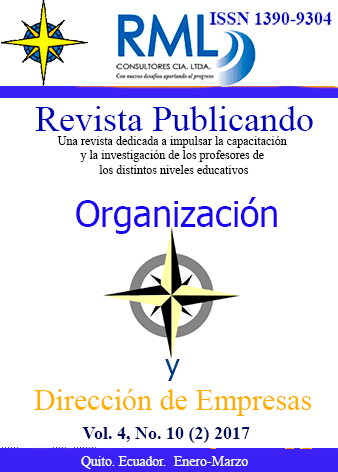Abstract
Actualmente, cada vez más empresas están conscientes y motivadas para adherirse a plataformas de colaboración como facilitadoras de negocios, permitiendo a grupos de empresas mejorar su oferta y competitividad. Como tal, el concepto de ecosistema empresarial se está convirtiendo en prominente. El análisis de la literatura muestra que una serie de contribuciones pueden encontrarse en varios campos de investigación, tales como, beneficios de colaboración y colaboración en la cadena de suministro. El propósito de este documento es el estudio de estas áreas, destacando sus posibles contribuciones sobre la evaluación de los beneficios y el desempeño en colaboración. Para ello se emplea como método investigativo una búsqueda bibliográfica en el directorio ScinceDirect y se seleccionan los artículos más citados en esta línea investigativa.
References
Alonso, J., de Soria, I. M., Orue-Echevarria, L., & Vergara, M. (2010). Enterprise collaboration maturity model (ECMM): preliminary definition and future challenges Enterprise Interoperability IV (pp. 429-438): Springer.
Belecheanu, R., Pawar, K. S., ckh Riedel, J., Santoro, R., & Conte, M. (2004). Aricon Initiative: Barriers in Adopting the Virtual Enterprise Approach in the New Product Development (NPD) Context Processes and Foundations for Virtual Organizations (pp. 123-134): Springer.
Botta-Genoulaz, V., Campagne, J.-P., Llerena, D., & Pellegrin, C. (2013). Supply chain performance: collaboration, alignment, and coordination: John Wiley & Sons.
Camarinha-Matos, L. M., & Afsarmanesh, H. (2004). The emerging discipline of collaborative networks. Paper presented at the Working Conference on Virtual Enterprises.
Camarinha-Matos, L. M., & Afsarmanesh, H. (2008). Collaborative networks: Reference modeling: Springer Science & Business Media.
Cao, M., Vonderembse, M. A., Zhang, Q., & Ragu-Nathan, T. (2010). Supply chain collaboration: conceptualisation and instrument development. International Journal of Production Research, 48(22), 6613-6635.
Graí§a, P., & Camarinha-Matos, L. M. (2017). Performance indicators for collaborative business ecosystems ”” Literature review and trends. Technological Forecasting and Social Change, 116, 237-255. doi:https://doi.org/10.1016/j.techfore.2016.10.012
Lytras, M. D., Mathkour, H. I., Abdalla, H., Al-Halabi, W., Yanez-Marquez, C., & Siqueira, S. W. M. (2015). An emerging – Social and emerging computing enabled philosophical paradigm for collaborative learning systems: Toward high effective next generation learning systems for the knowledge society. Computers in Human Behavior, 51, Part B, 557-561. doi:https://doi.org/10.1016/j.chb.2015.06.004
Moore, J. (1996). Death of Competition. the Age of Business Ecosystems. Fortune.
Moore, J. F. (1993). Predators and prey: a new ecology of competition. Harvard Business Review, 71(3), 75-83.
Nachira, F. (2002). Towards a network of digital business ecosystems fostering the local development.
Nachira, F., Dini, P., & Nicolai, A. (2007). A network of digital business ecosystems for Europe: roots, processes and perspectives. European Commission, Bruxelles, Introductory Paper.
Nicholson, J., Gimmon, E., & Felzensztein, C. (2017). Economic Geography and Business Networks: Creating a Dialogue between Disciplines: An Introduction to the Special Issue. Industrial Marketing Management, 61, 4-9. doi:https://doi.org/10.1016/j.indmarman.2017.01.009
Piot, G., Pouly, M., Cheikhrouhou, N., & Glardon, R. (2007). An estimation model for business benefits in horizontal collaborative networks. Establishing the Foundation of Collaborative Networks, 345-352.
Romero, D., & Molina, A. (2009). VO breeding environments & virtual organizations integral business process management framework. Information Systems Frontiers, 11(5), 569.
Vereecke, A., & Muylle, S. (2006). Performance improvement through supply chain collaboration in Europe. International journal of operations & production management, 26(11), 1176-1198.
Whipple, J. M., & Russell, D. (2007). Building supply chain collaboration: a typology of collaborative approaches. The International Journal of Logistics Management, 18(2), 174-196.
You are free to:
Share — copy and redistribute the material in any medium or format.
Adapt — remix, transform, and build upon the material.
The licensor cannot revoke these freedoms as long as you follow the license terms.
Under the following terms:
Attribution — You must give appropriate credit, provide a link to the license, and indicate if changes were made. You may do so in any reasonable manner, but not in any way that suggests the licensor endorses you or your use.
NonCommercial — You may not use the material for commercial purposes.
ShareAlike — If you remix, transform, or build upon the material, you must distribute your contributions under the same license as the original.
No additional restrictions — You may not apply legal terms or technological measures that legally restrict others from doing anything the license permits.
